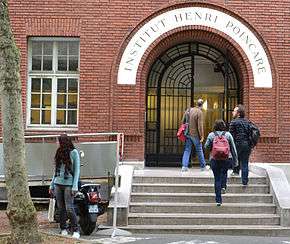Institut Henri Poincaré
The Henri Poincaré Institute (or IHP for Institut Henri Poincaré) is a mathematics research institute in the 5th arrondissement of Paris, on the Sainte-Geneviève Hill, close to a number of other higher education institutions. It is part of UPMC Sorbonne Universités, in association with the Centre national de la recherche scientifique (CNRS).
History
Just after World War I, mathematicians Émile Borel in France and George Birkhoff in the United States persuaded American and French sponsors (Edmond de Rothschild and the Rockefeller Foundation respectively)[1] to fund the building of a centre for lectures and international exchanges in mathematics and theoretical physics. The Institute was inaugurated on 17 November 1928 and named after French mathematician Henri Poincaré (1854-1912).
Right from the start, the institute's objective has been to promote mathematical physics, and it soon became a favourite meeting place for the French scientific community. In the 1990s, the IHP became a thematic institute modeled on Berkeley's Mathematical Sciences Research Institute (MSRI) and a place for contact making, exchange and diffusion of knowledge.
Organization
The IHP's governing board has about 25 members. There are no permanent researchers other than the director and the deputy director. Since 2009, the institute has been headed by mathematician Cédric Villani (director), Fields Medals laureate in 2010. The current deputy director is the French cosmologist Jean-Philippe Uzan.
Together with the Institut des Hautes Études Scientifiques (IHES), the Centre International de Rencontres Mathématiques (CIRM) and the Centre International de Mathématiques Pures et Appliquées (CIMPA) it is a member of the Carmin LabEx (Laboratory of Excellence), which aims at facilitating exchanges between mathematicians by building infrastructures for pooling skills and information.

Scientific activities
As a venue for national and international mathematical exchanges, the Institute organizes "thematic quarters" (three-month programmes on specific topics), intensive short-time collaborations, high-level PhD training courses, conferences and seminars in mathematics or related fields, such as physics, biology or computer science. Topics are selected by the IHP's Scientific Steering Committee. The IHP welcomes around 11,000 mathematicians each year.
In 2013, the Institute launched the "Poincaré Chair", a research program designed to foster the international careers of talented young researchers. Numerous seminars or series of lectures take place at the IHP, such as the Bourbaki and Bourbaphy Seminars, the History of Mathematics Seminar, as well as some more specialised lectures in algebra, number theory, mathematical physics, elliptic curves ...
The institute also publishes three international scientific journals, the Annals of the Institut Henri Poincaré (Journal of Theoretical and Mathematical Physics, Probability and Statistics and Non Linear Analysis), with original advanced fundamental research articles. A fourth journal is under consideration.
General public
As a showcase for French mathematics, the Institute co-organises and sponsors numerous, scientific and cultural events aimed at a general public (2011 : Mathematics, a Beautiful Elsewhere at the Fondation Cartier ; 2011 : A tribute to Evariste Galois ; 2012 : Centenary of Henri Poincaré's Death...). it has close ties with the associations and societies for the promotion of mathematics housed in its premises.
Mathematical designs
The library of the Henri Poincaré institute holds a collection of some 400 mathematical models and designs that come in different materials: glass, plastic, cardboard, wire, sewing thread on a rigid frame, plaster. This collection, which started with a donation by Martin Shilling, has been enhanced over the years, notably by wooden models built between 1912 and 1914 by lecturer Joseph Caron of the École Normale Supérieure.
Head of Institut Henri Poincaré
- 1928-1948 : Émile Borel
- 1949-1986 : Paul Belgodère
- 1990-1994 : Pierre Grisvard
- 1994-1995 : Joseph Oesterlé
- 1999-2008 : Michel Broué
- Since 2009 : Cédric Villani
See also
References
- ↑ Rockefeller and the internationalization of mathematics between two World Wars [Texte imprimé][: documents and studies for the social history of mathematics in the 20th century / Reinhard Siegmund-Schultze. - Basel ; Boston ; Berlin : Birkhäuser, cop. 2001. - 1 vol. (XIII-341 p.) : fig., ill., carte ; 24 cm. - (Science networks historical studies ; volume 25). - Bibliogr. p. [307]-318. Index. ISBN 3-7643-6468-8 (rel.). - EAN 9783764364687 (rel.)]
External links
- IHP welcome Institute homepage
- A short history of the Institute (in French, 1993)
Coordinates: 48°50′41″N 2°20′38″E / 48.84472°N 2.34389°E